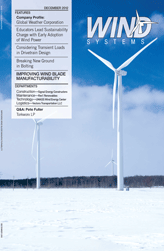One of the most common, and most critical, components in any piece of machinery is the bolted joint. In wind turbines especially, nuts and bolts are found from ground level to the very top, and everywhere in between.
Safety is paramount in these high flying applications, and utilizing a bolting method that tightens your nuts and bolts quickly, correctly, effectively, and safely, is priority number one. The unique challenges that a wind turbine presents make this a difficult task. In addition, an improperly bolted joint can result in damaged equipment, and frequent maintenance checks, all of which affect the bottom line.
Clamp Load and Other Considerations
Control of the clamp load in a bolted joint is vital. However, when faced with a tricky joint, sometimes the design engineer will not have an answer if asked about the clamp load. Torque calculations must always be based on the existing conditions that often are very vague. Unless all parameters are correct, the calculation will be unreliable. Here are a few parameters that should be considered:
• Thread condition of the fasteners
• Hardness of contact surface
• Material (steel, aluminium, copper, etc.)
• Extra friction from a locking fastener
• Extra friction from an adhesive
• Lubricant on the thread
• Type of bolt head (flanged, regular or serrated)
• Surface coating of the bolt
• New or reused fastener
During tightening, bolts are subjected to both tensile and torsional stress. The total stress in a bolt can be calculated using the formula:
Total stress = ![]()
In order to maximize the desired tensile stress (σx) it is vital to minimize the torsional stress (τxy). Tensile stress (clamp load) is achieved when the bolt is axially elongated. Unwanted torsional stress (twisting) in bolts arises during tightening due to thread friction. High thread friction increases torsional stress and causes yielding at lower clamp load levels than normal.
A lubricant is necessary to minimize torsional stress. However, many commonly used bolt-locking systems are based on increased thread friction (deformed nuts, adhesives, etc). Minimizing thread friction and safely securing a joint has often been considered impossible. The use of locking systems that increase thread friction is the single most common reason why the full capacity of bolted joints is not utilized. The following example illustrates the problem.
Applying an adhesive significantly increases thread friction during tightening. The red graphs (Figure 1) show tightening of bolts with adhesive on the threads. Due to increased thread friction and torsional stress, only half as much clamp load is obtained before reaching the yield points (marked with x). When tightening the same bolts lubricated, which is illustrated by the green graphs, almost twice as much clamp load is obtained. The diagram clearly shows why low (and uniform) friction during tightening is necessary to ensure that the bolts’ full capacity can be used.
Under static load the achieved clamp load in a joint is maintained. However, bolted joints exposed to dynamic loads or vibrations are likely to gradually loosen. Even if some of the common bolt locking methods (such as serrated washers, adhesives or deformed nuts) work fairly well when the dynamic loads are light, wind turbine applications can see significant vibration and often need to be retightened and checked regularly.
Nord-Lock Wedge-Locking Washers
One option that is being used more and more in wind turbine bolting is the Nord-Lock washer. The Swedish company Nord-Lock produces this high-quality bolt securing system, consisting of a pair of pre-assembled washers. The washers have a cam angle “α”, which is greater than the thread pitch “β”. In addition, there are radial teeth on the opposite sides of the washers (Figure 2).
The washers are installed in pairs, cam face to cam face. When the bolt or nut is tightened the teeth grip and seat the mating surfaces. The washers are locked in place, allowing movement only across the face of the cams. Any loosening attempt of the bolt/nut to rotate loose is blocked by the wedge effect of the cams.
Nord-Lock has developed in-house laboratories where clients get the opportunity to put joints from their own applications to the test. In simulations of real-life conditions torque-load ratios are measured and Junker vibration tests are performed (Figure 3). In a Junker vibration test (meeting DIN 65151) bolted joints are subjected to transverse movements while a load cell continuously measures the bolt tension. The Junker test is used to compare different bolted joint configurations and is a first step in selecting the best technical solution to prevent bolt loosening. The Junker test is often considered a worst-case scenario and bolted joints performing well in this test normally function flawlessly in real life conditions. In Figure 3 you see that many commonly used bolt-securing devices show limited locking performance when exposed to vibration.
Bolted joints secured by NordLock lose some minimal initial preload due to normal settlements between the contact surfaces. The unique wedge-locking effect is verified by the increase in clamp load during untightening.
For wind turbines, which require regular service and maintenance, this is the optimum solution. The bolted joints are easily assembled and disassembled and no special tools are needed. Because Nord-Lock washers use tension instead of friction to secure bolted joints, the locking function is not affected by lubrication. The use of a good lubricant is recommended in order to reduce torsional stress, minimize clamp load deviation, and to protect against corrosion. Since the clamp load deviation is very low when tightening lubricated fasteners, bolted joints can always be safely locked at the highest possible preload level.
X-Series Washers
An enhanced version of the Nord-Lock washer, called the X-series, introduces a spring effect which can be especially beneficial in critical wind turbine applications. The wedge effect prevents bolt loosening, and the spring effect compensates for loss of preload due to settlement that can occur due to thick surface coatings, materials like polymers and composites, soft metals, multiple clamped parts, and other design issues.
How They Work
After the fastener is tightened, the X-series washer flattens and the serrations engage the contact surfaces. The cam angle being greater than the thread pitch, the wedge-locking effect prevents rotation of the fastener. After tightening, the joint settles and the fastener sinks into the surface material. The spring effect in the washer counteracts the slackening movement of the bolt, minimizing loss of preload on the joint (Figure 4). This is the first multi-functional wedge-locking washer and is of particular interest in wind turbine bolting applications.
Large Diameters
When dealing with larger size bolting diameters, one of the problems that arise is that the amount of torque required to attain a given preload increases exponentially as the diameter increases. This means that special tooling is usually required to achieve the required preload.
In the case of wind turbines, this means getting some expensive and heavy tooling into some pretty interesting places. These methods can also cause problems with joint integrity or do not provide consistent bolt load across the bolted surface. The conventional hex nut and bolt have been around so long we often don’t give them a second thought. However, there is another interesting bolting technology being put to good use by many wind farms.
Multi-Jackbolt Tensioners
An alternative to using high-powered tooling on existing nuts and bolts is the Superbolt multi-jackbolt tensioner (MJT). Instead of turning a hex nut or bolt to obtain preload, MJTs use a number of smaller jackbolts (Figure 5). The benefit is that any size MJT tensioner can be installed and removed using a hand held electric/air tool or torquewrench. This is a huge advantage in wind turbine applications where location can make it difficult to utilize heavy tooling. Worker safety is increased, and expensive tooling is eliminated.
How MJTs Work
Each tensioner consists of a hardened washer, a nut body and jackbolts. The jackbolts are threaded through the round nut body or bolt head, and thrust against the hardened washer to stretch the stud/bolt and generate clamping force (Figure 6).
The torque needed to tighten each jackbolt is small and easy to obtain, thus enabling the use of small hand tools. The amount of preload achieved is directly proportional to the size and number of jackbolts used (Figure 7).
Advantages
Besides the increased worker safety and tooling benefits, MJT tensioners also help to improve the entire bolting system. Design engineers in particular find this technology of high interest, and many OEM’s utilize MJTs to improve their equipment design.
Torquing conventional hex nuts and bolts causes twisting of the main bolt. This can add unwanted internal stresses and reduce the load capacity. Superbolt tensioners tighten in pure tension, so there is no torsion on the main bolt. Also, since the main thread does not slide under load, no thread galling or stud seizure occurs.
Another problem with hex nuts and bolts is that there is a high stress concentration found on the first few threads. By comparison, the jackbolts in the MJT system create hoop stresses in the nut body, so the nut flexes out slightly at the bottom and in slightly at the top (Figure 8). This flexing distributes the load throughout the entire thread engagement, and also adds elasticity, which can make short, stubby bolts much less likely to break due to fatigue stress.
One perceived downside with the MJT system, however, is the fact that there are multiple jackbolts to tighten. You would think the multiple jackbolts would result in longer installation and removal times. However, the MJT system has been proven to reduce installation and removal times. For example, a 1-1/2” tensioner can be tightened in about 1 minute and 29 seconds and a 2” tensioner would be around 1 minute and 33 seconds.
In conclusion, if you are experiencing bolting problems on one of the many wind turbine bolting applications, or want to make the bolting process easier and safer for your workers, these two technologies are being used with success and could be a viable alternative for you.








































